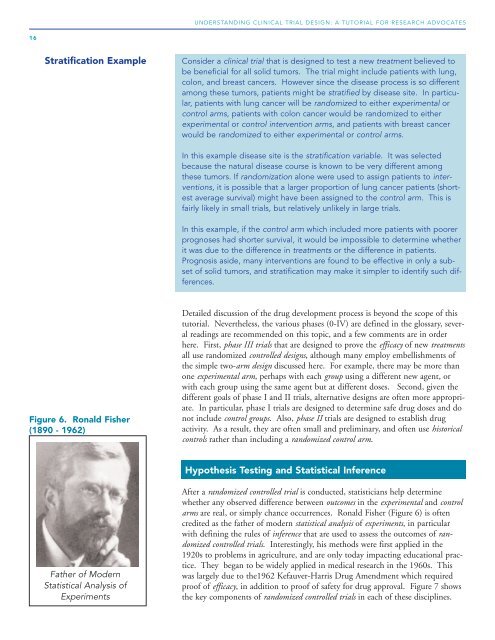Understanding Clinical Trial Design - Research Advocacy Network
Understanding Clinical Trial Design - Research Advocacy Network
Understanding Clinical Trial Design - Research Advocacy Network
Create successful ePaper yourself
Turn your PDF publications into a flip-book with our unique Google optimized e-Paper software.
16<br />
Stratification Example Consider a clinical trial that is designed to test a new treatment believed to<br />
be beneficial for all solid tumors. The trial might include patients with lung,<br />
colon, and breast cancers. However since the disease process is so different<br />
among these tumors, patients might be stratified by disease site. In particular,<br />
patients with lung cancer will be randomized to either experimental or<br />
control arms, patients with colon cancer would be randomized to either<br />
experimental or control intervention arms, and patients with breast cancer<br />
would be randomized to either experimental or control arms.<br />
Figure 6. Ronald Fisher<br />
(1890 - 1962)<br />
Father of Modern<br />
Statistical Analysis of<br />
Experiments<br />
UNDERSTANDING CLINICAL TRIAL DESIGN: A TUTORIAL FOR RESEARCH ADVOCATES<br />
In this example disease site is the stratification variable. It was selected<br />
because the natural disease course is known to be very different among<br />
these tumors. If randomization alone were used to assign patients to interventions,<br />
it is possible that a larger proportion of lung cancer patients (shortest<br />
average survival) might have been assigned to the control arm. This is<br />
fairly likely in small trials, but relatively unlikely in large trials.<br />
In this example, if the control arm which included more patients with poorer<br />
prognoses had shorter survival, it would be impossible to determine whether<br />
it was due to the difference in treatments or the difference in patients.<br />
Prognosis aside, many interventions are found to be effective in only a subset<br />
of solid tumors, and stratification may make it simpler to identify such differences.<br />
Detailed discussion of the drug development process is beyond the scope of this<br />
tutorial. Nevertheless, the various phases (0-IV) are defined in the glossary, several<br />
readings are recommended on this topic, and a few comments are in order<br />
here. First, phase III trials that are designed to prove the efficacy of new treatments<br />
all use randomized controlled designs, although many employ embellishments of<br />
the simple two-arm design discussed here. For example, there may be more than<br />
one experimental arm, perhaps with each group using a different new agent, or<br />
with each group using the same agent but at different doses. Second, given the<br />
different goals of phase I and II trials, alternative designs are often more appropriate.<br />
In particular, phase I trials are designed to determine safe drug doses and do<br />
not include control groups. Also, phase II trials are designed to establish drug<br />
activity. As a result, they are often small and preliminary, and often use historical<br />
controls rather than including a randomized control arm.<br />
Hypothesis Testing and Statistical Inference<br />
After a randomized controlled trial is conducted, statisticians help determine<br />
whether any observed difference between outcomes in the experimental and control<br />
arms are real, or simply chance occurrences. Ronald Fisher (Figure 6) is often<br />
credited as the father of modern statistical analysis of experiments, in particular<br />
with defining the rules of inference that are used to assess the outcomes of randomized<br />
controlled trials. Interestingly, his methods were first applied in the<br />
1920s to problems in agriculture, and are only today impacting educational practice.<br />
They began to be widely applied in medical research in the 1960s. This<br />
was largely due to the1962 Kefauver-Harris Drug Amendment which required<br />
proof of efficacy, in addition to proof of safety for drug approval. Figure 7 shows<br />
the key components of randomized controlled trials in each of these disciplines.


